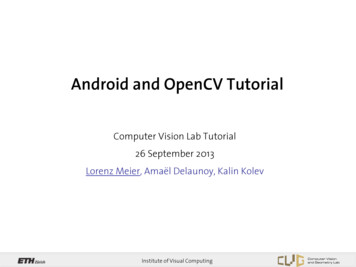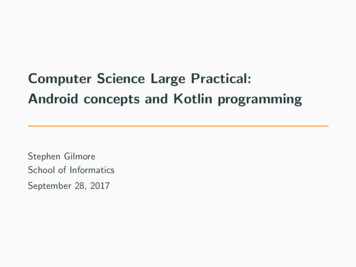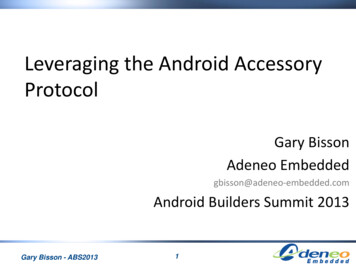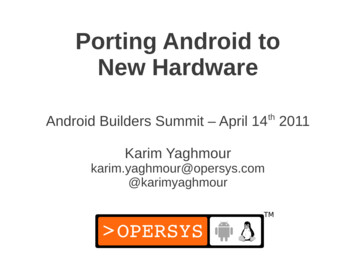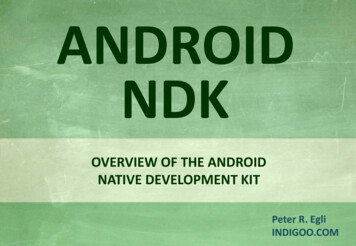
Transcription
Android NDK – Native Development Kitindigoo.comANDROIDNDKOVERVIEW OF THE ANDROIDNATIVE DEVELOPMENT KIT Peter R. Egli 2015Peter R. EgliINDIGOO.COM1/16Rev. 1.40
Android NDK – Native Development Kitindigoo.comContents1.2.3.4.5.6.7.8.9.10.11.What you can do with NDKWhen to use native codeStable APIs to use / available librariesBuild native applications with NDKNDK contents and structureNDK cross-compiler suiteAndroid EABINDK C supportJNI - Calling native functions from Java codeSDK project with native codeNative activity Peter R. Egli 20152/16Rev. 1.40
Android NDK – Native Development Kitindigoo.com1. What you can do with NDK Build native libraries that are callable from Android Java application code (JNI).Build executables (non-recommended use of NDK).Debug native program (with gdb).Dalvik VMAndroid application (*.apk)Android Java applicationJNINative library (*.so)Recommended use of native functions:An Android Java application makes nativecalls through JNI.Thus the entire application running in the VMis subject to the definedAndroid application lifecycle.It is possible to run entirely native applicationson Android. However, it isrecommended to use a small Java wrapperfor managing the lifecycle of the application(start, stop).Stable native libraries(libc, libm, liblog ) Peter R. Egli 20153/16Rev. 1.40
Android NDK – Native Development Kitindigoo.com2. When to use native codeThe power of Android lies in the rich Java application framework to be used by Androidapplications written in Java.In special cases, however, it may be required to write native code that directly runs on the CPUwithout the Android VM interpreter.NDK is a toolkit for writing and integrating native code with Java application code.Native code characteristics for use in Android: Graphically and computationally intensive (e.g. complex algorithms) Few library dependencies (restricted to stable Android libraries provided by NDK) Little interaction between Java application code and native code (ideally, the Javaapplication calls computationally intensive native functions and receives the result; thereshould not be frequent calls and callbacks between Java and native code)Primary uses of NDK:NDK should be used to build native libraries (shared objects) that are called by an Androidapplication.Entirely native applications without Java code are possible starting from Android 2.3(Gingerbread) by using NativeActivity.Non-recommeded uses of NDK:Custom native applications that run outside the VM. Peter R. Egli 20154/16Rev. 1.40
Android NDK – Native Development Kitindigoo.com3. Stable APIs to use / available librariesThe Android NDK contains a small number of stable libraries that are guaranteed to becontained in successive Android versions.It is recommended that native code only make use of these stable libraries. If native code usesnon-stable libraries, the native application may break upon an Android update.Librarycrtbegin dynamic.ocrtbegin so.ocrtbegin static.ocrtend android.ocrtend so.olibandroid.solibc.solibdl.solibEGL.solibGLESv1 libOpenMAXAL.solibOpenSLES.solibstdc .solibthread db.so Peter R. Egli 2015DescriptionCalls of global object ctorsCalls of global object ctorsCalls of global object ctorsCalls of global object dtorsCalls of global object dtorsFunctions for access to Java platform from native codeStandard C library (bionic)Dynamic linker libraryInterface library for low level graphics buffer accessOpen GL graphics libraryOpen GL graphics libraryC-function-based library for graphics pixel accessAndroid logging libraryMath libraryAudio and video streaming libraryAudio streaming libraryMinimal C library (no exceptions, no RTTI)Thread debug support library.android-5android-6android-3 android-4 android-7 android-8 android-9 android-14Android 1.5 Android 1.6 Android 2.0 Android 2.2 Android 2.3 Android sYes5/16Rev. 1.40
Android NDK – Native Development Kitindigoo.com4. Build native applications with NDKThe NDK build system is made for creating .a (static libs) and .so (shared libs).The shell script NDK-base /ndk-build creates the library output.With some minimal effort it is possible to create fully native applications:C/C sourcendk-build.o.a.soNDKarm-eabi-ldC/C source(main) Peter R. Egli aries6/16Rev. 1.40
Android NDK – Native Development Kitindigoo.com5. NDK contents and structure (1/2)NDK installation simply requires unzipping it to a suitable location.NDK contains a cross-toolchain for ARM and x86 based CPUs, header files and stable libraries.NDK R7 structure:Build scripts (makefiles, awk scripts etc.)Documentation (HTML)Platforms (header files and stable libraries)Build executables (make, awk, sed, echo)Samples (hello world, JNI example etc.)Source files that can be linked to an application or libraryTest scripts for automated tests of the NDKARM Linux and x86 toolchains (compiler, linker etc.)Documentation entry pointMakefile for building NDKBuild script for building a native application or libraryExperimental Windows native build script (working?)GDB debug start scriptStack trace analysis toolReadme fileNDK release identifier (contents for R7: r7d) Peter R. Egli 20157/16Rev. 1.40
Android NDK – Native Development Kitindigoo.com5. NDK contents and structure (2/2)The platforms sub-folder contains stable header files and libraries.Android API-level 9 (Android 2.3)ARMv7 CPU architecture header files and libs ('sysroot')Stable Android API header files and librariesC headers and libraries are under NDK-base /sources/cxx-stl. Peter R. Egli 20158/16Rev. 1.40
Android NDK – Native Development Kitindigoo.com6. NDK cross-compiler suite (1/3)Standard naming convention for cross-compilers: arch - vendor -(os)- abi Example:arm-linux-androideabi-c .exe Architecture (CPU): ARM Vendor: None OS: Linux ABI: Android EABI (see below)NDK toolchains:NDK contains GNU-based cross-compile tools for ARM7 and x86 CPUs.The NDK toolchain can be used for:a. NDK integrated toolchain for building shared libraries for use in an Android applicationb. Standalone toolchain that is invoked by a custom build Peter R. Egli 20159/16Rev. 1.40
Android NDK – Native Development Kitindigoo.com6. NDK cross-compiler suite (2/3)a. NDK integrated toolchain:Location: NDK-base indows (likewise forx86 toolchain).The NDK integrated toolchain uses the scripts, header files and library files that are part of theNDK installation.NDKtoolchain(ndk-build) Peter R. Egli 201510/16Rev. 1.40
Android NDK – Native Development Kitindigoo.com6. NDK cross-compiler suite (3/3)Standalone toolchain:The NDK standalone toolchain is useful for situations where another build system, e.g. as partof an open source package, needs to invoke a cross-compiler for building.In the standalone toolchain, everything that is needed for building (compilers etc., header files,library files) is contained in a single location.How to create standalone-toolchain:1. Start bash shell (on Windows start cygwin shell as administrator)2. Run the make standalone toolchain k-r7b/build/tools/makestandalone-toolchain.sh --platform android-9 --installdir /cygdrive/c/temp/android-standalone-toolchain/How to invoke the standalone-toolchain:SET PATH c:\temp\android-standalone-toolchain;%PATH%SET CC arm-linux-androideabi-gcc.exe%CC% -o foo.o –c foo.c Peter R. Egli 201511/16Rev. 1.40
Android NDK – Native Development Kitindigoo.com7. Android EABIWhat is an ABI?ABI (Application Binary Interface) defines how an application interacts with the underlyingsystem at run-time.An ABI is a low-level interface definition that comprises the following:- CPU instruction set to use- Endianness of memory load and store operations- Format of executable binaries (programs, libraries)- Function call conventions (stack framing when functions are called, argument passing)- Alignment of structs and struct fields, enumsThe goal of an ABI is binary compatibility between executables (e.g. program calling a libraryfunction).An EABI (Embedded ABI) defines an ABI for embedded targets.Android EABI:Android EABI is basically identical to the Linux (GNU) EABI with the difference of the C-library(bionic C-library instead of GNU C-library).Android provides 3 EABIs:a. armeabi (ARMv5TE instruction set, thumb mode)b. armeabi-v7a (Thumb-2 instruction set extensions, hardware floating point support)c. x86 (IA-32 based instruction set)For more details see NDK-base /docs/CPU-ARCH-ABIS.html Peter R. Egli 201512/16Rev. 1.40
Android NDK – Native Development Kitindigoo.com8. NDK C supportNDK provides some basic C runtime support through the default /system/lib/libstdc library.The following C features are not supported:- C exceptions- RTTI (Run-Time Time Information)- Standard C libraryC runtimes:NDK provides different libraries (run-times) with different levels of C support:C RuntimeLibraryC exceptionsRTTIStandard C librarysystemlibstdc NoNoNogabi libgabi YesYesApplication files must all be linked against the same runtime library (mixing is not possible).The C runtime is specified in the (optional) Application.mk makefile.Static versus shared libraries:Shared libraries are the preferred mode of library use to conserve space (library not containedmultiple times in different executables) and avoid problems with global library variables.More details see CPLUSPLUS-SUPPORT.html. Peter R. Egli 201513/16Rev. 1.40
Android NDK – Native Development Kitindigoo.com9. JNI - Calling native functions from Java codeJava code:Declaration of native function that is contained in a library.Native code:jstringJava path to Java package Java-Class function-name (JNIEnv* env,jobject thiz){ }where JNIEnv identifies the JNI context of the calling VM and jobject is a reference tothe calling Java object. Peter R. Egli 201514/16Rev. 1.40
Android NDK – Native Development Kitindigoo.com10. SDK project with native code1. Build native sources to library with ndk-build2. Compile Android Java sources with ADT plugin3. Create Android application package (.apk) with ADT d).apk Peter R. Egli 201515/16Rev. 1.40
Android NDK – Native Development Kitindigoo.com11. Native activityAndroid provides to possibility to implement a completely native activity.Possible use cases:a. Games (direct access from native code to graphics)b. Use of existing application code available in C Native activities are still running in the VM. Thus the lifecycle for normal Android applicationstill applies. Native activities can be started in 2 ways: Small Java Wrapper starts native activity Attribute HasCode true in manifest Native activity directly started Attribute HasCode false in manifestJava wrapperNativeactivity inC/C Nativeactivity inC/C *.apk package*.apk package Peter R. Egli 201516/16Rev. 1.40
Android NDK - Native Development Kit indigoo.com 7. Android EABI What is an ABI? ABI (Application Binary Interface) defines how an application interacts with the underlying system at run-time. An ABI is a low-level interface definition that comprises the following: - CPU instruction set to use - Endianness of memory load and store operations



